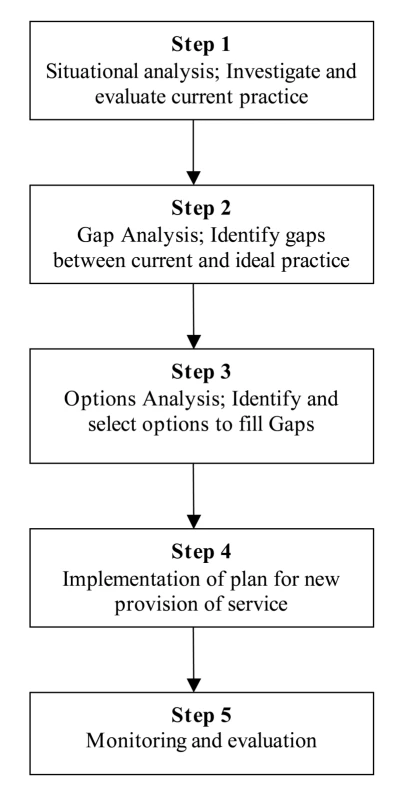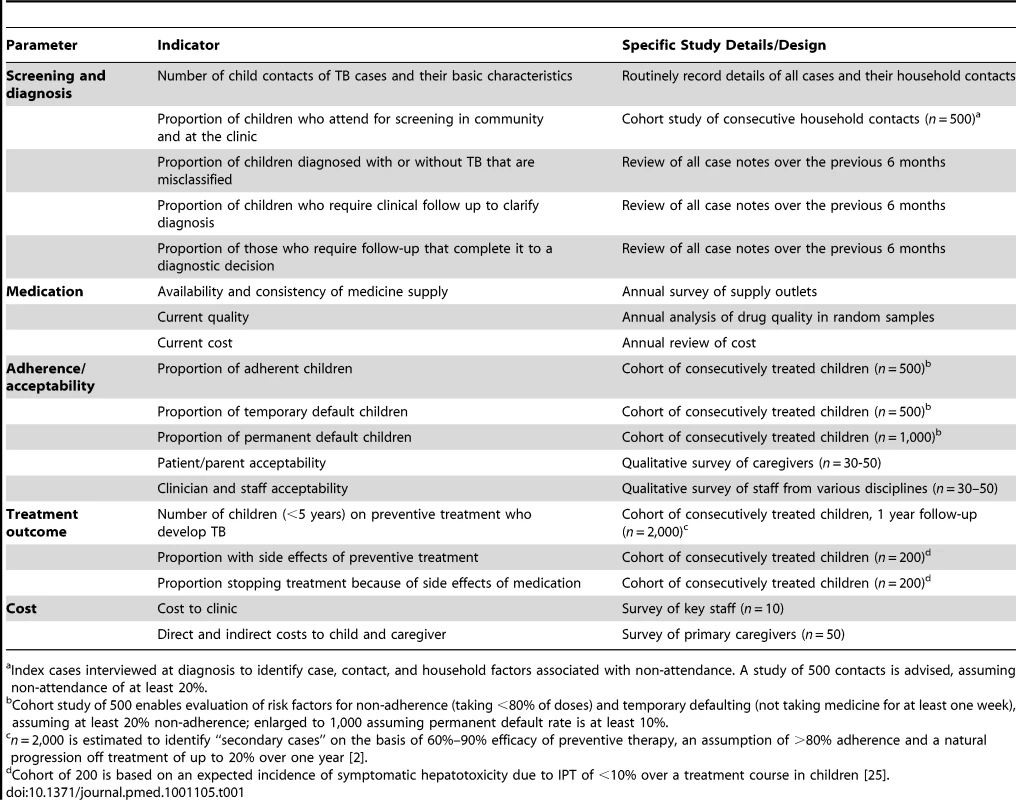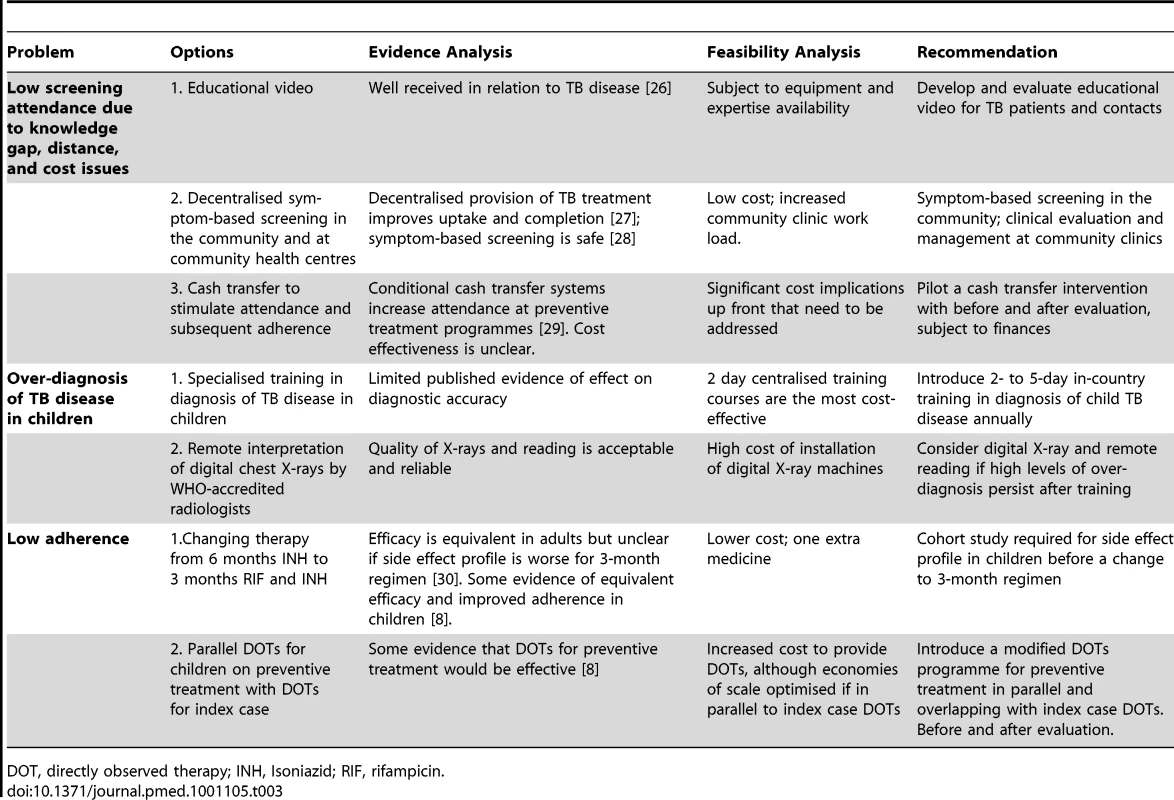Closing the Policy-Practice Gap in the Management of Child Contacts of Tuberculosis Cases in Developing Countries
article has not abstract
Published in the journal:
. PLoS Med 8(10): e32767. doi:10.1371/journal.pmed.1001105
Category:
Policy Forum
doi:
https://doi.org/10.1371/journal.pmed.1001105
Summary
article has not abstract
Summary Points
-
Children in contact with an adult with smear-positive tuberculosis (TB) are at high risk of being infected themselves and progressing to TB disease.
-
The World Health Organization recommends that such children, if aged under 5 years, should receive preventive treatment once TB disease has been ruled out.
-
This policy is rarely implemented and attempts to do so have had disappointing results.
-
We propose a new approach using a health needs assessment framework, research tools, and a strategy for clinical evaluation.
-
We show how this approach could be applied and evaluated by National TB Control Programs.
The Policy-Practice Gap Regarding Children in Contact with a Tuberculosis Case
The prevention, diagnosis, and treatment of tuberculosis (TB) in children are of particular importance in developing countries where TB is endemic [1]. Child contacts of an adult with sputum smear–positive TB are at high risk of infection with Mycobacterium tuberculosis and subsequent early progression to TB disease [2]. Anti-tubercular antibiotic prophylaxis is highly effective in preventing progression to disease in children infected with M. tuberculosis, with protection of up to 90% [3]. Therefore, the World Health Organization (WHO) recommends that all children <5 years who are a household contact of a sputum smear–positive case should receive preventive treatment, once TB disease has been ruled out [4]. Box 1 summarises the 2006 WHO recommendation for contact management as a symptom-based approach, whereby most child contacts can be placed immediately on preventive treatment without the need for formal clinical evaluation.
Box 1. A symptom-based approach to child contacts of adult TB cases
Children who are household contacts of a sputum smear–positive adult TB case are initially evaluated in the community. If asymptomatic and less than 5 years of age, they are immediately commenced on preventive treatment. If they have symptoms consistent with TB disease they are referred for clinical workup. Those diagnosed with TB disease undergo a full course of multi-drug treatment. Those less than 5 years of age who are not diagnosed with TB disease receive preventive treatment.
2006 WHO Guidance for National Tuberculosis Programmes on the Management of Tuberculosis in Children.
Of concern, the WHO recommendation for the management of child contacts of a sputum smear–positive index case is rarely implemented, despite being incorporated widely into National TB Control Program (NTP) guidelines [5]–[7]. Possible reasons for this include that limited NTP resources are focused on the management of TB disease, the perceived need for specialised services and investigations to provide adequate clinical evaluation, and concerns regarding re-infection and poor adherence in relation to the development of resistance [7]–[10]. Furthermore, attempts to implement the policy have been characterised by low attendance for screening, poor adherence to preventive treatment, and high defaulting rates [9],[11],[12]. Specific barriers in relation to preventive treatment that have been identified include issues of knowledge, understanding, and perception in TB patients and TB program staff [5],[13], lack of an appropriate management structure and necessary tools [6], treatment side effects [14], transport difficulties, and cost [10],[13],[14]. However, the literature with respect to barriers in the management of child contacts of TB cases in developing countries is relatively sparse.
It is clear that there is a policy-practice gap that needs to be addressed. Here, we propose an evidence-based approach to close this gap and show how this can lead to the management of child contacts of TB cases being properly incorporated into NTP activities, applied in the community and clinic, and formally evaluated.
Closing the Gap
We propose the employment of an innovative combination of a health needs assessment (HNA) public health framework, integrated research tools, and a clinical evaluation plan in those child contacts with symptoms. The key steps of an HNA as a public health framework are described in Figure 1 [15]. An initial situational analysis of current practice is followed by identification of the gaps between current and ideal practice. This is followed by a process whereby options for filling the gaps are considered and the most appropriate recommended. These are then brought together and implemented as new routine practice. Once implemented, the new service is monitored and evaluated. This public health framework has been used to match health needs and provision in populations [15]. Quantitative and qualitative research tools have been integrated to provide a clear understanding of need [16]. The framework can be applied to specific health issues. For example, it has been adopted as a tool to develop a way forward for the rational use of oxygen in child pneumonia in West Africa [17],[18]. To the best of our knowledge, other than the step of situational analysis [5], it has not been applied to child TB case contact management.

Situational Analysis
The indicators that should be included in the situational analysis of the management of child contacts of adult TB cases are summarised in Table 1. These cover basic demographic details of the TB cases that attend clinics and their child contacts, the performance and capacity of the system to deliver proper evaluation and management of TB contacts, key aspects of drug supply and quality, adherence and defaulting in relation to preventive and curative treatment, treatment outcome, attitudes and acceptability of child contact management by staff and primary caregivers, and cost analyses.

The research tools that are required include relatively large cross-sectional and cohort studies as well as qualitative methods and focused cost questionnaires. We note that longitudinal follow-up of those placed on preventive treatment currently offers limited information at the situational analysis stage if preventive treatment is not practiced. We propose a single cohort study with recruitment extended to meet the requirements of each question (up to a maximum of 2,000 contacts for the disease outcome) and sufficient follow-up time of 1 year. Such an approach enables risk factors and barriers related to particular gaps to be identified (Table 2) and fed into the evidence base for the options process (Table 3). It is not absolutely necessary to have a secondary disease outcome indicator, as the efficacy of preventive therapy can be assumed from the literature. However, a baseline understanding of the incidence rate of secondary disease in a particular population is valuable for future comparisons. Cost analyses include both direct (costs to the patient/contacts and the health care provider to access care and provide treatment) and indirect costs (non-health care costs that result from engagement with the health system). By collecting direct and indirect cost information for exposed children who have preventive treatment and those who do not, the importance of economic barriers to screening and therapy can be established. For such an evaluation, an asset-based measure of wealth can be used to estimate the extent to which financial constraints impact on caregivers' decisions [19]. The qualitative studies provide new insights into factors that may be important with respect to attendance at screening and adherence to medication, as well as caregiver and staff knowledge and attitudes.


Gap Analysis
During the gap analysis, disparities between current and ideal practices are quantified for each component. Table 2 shows examples of how each gap can be identified and described. This is undertaken for each component of the situational analysis. In most situations, it is expected that the extent of the gap can be clearly defined. However, it may be necessary to estimate the gap based on limited information. If this estimate is too imprecise, further research may be required to define the gap.
Options Analysis
Following the identification of gaps between the current and ideal practices, options for closing these are reviewed. Each option is considered for scientific evidence of efficacy, feasibility in the specific setting, and cost evaluation from case contact household and societal perspectives. For each gap, an option to take forward for implementation is then recommended. Table 3 shows how the options can be presented.
Besides indicating the best possible intervention to improve the program, the options analysis will also lead to identification of information gaps in the literature where options for addressing an aspect of the current situation are unclear or unproven. In such circumstances, research may need to be undertaken to provide the necessary information. These research projects may range from simple cross-sectional evaluations to randomised intervention trials with follow-up. However, it is anticipated that a “best guess” for a decision on a way forward in some areas may simply be pragmatically necessary to develop a multi-component management plan that can be piloted in reasonable time.
Clinical Evaluation of Child Contacts with Symptoms of TB Disease
A child TB contact management plan with a view to routine use of preventive treatment in those without symptoms of disease needs to include an approach to the diagnosis/exclusion of TB disease in symptomatic contacts of any age. The implication of using the WHO symptom-based approach is that those children who are asymptomatic can go directly onto preventive treatment, while those with defined symptoms immediately enter a clinical evaluation plan that either leads to full TB treatment for disease or, if active disease is excluded, to commencement of preventive treatment (see Box 1). Indeed, the process of contact screening will improve case-detection and treatment of TB because of the high prevalence of disease in contacts of any age [20]. The International Union Against Tuberculosis and Lung Disease has developed training tools that include management algorithms for the evaluation of symptomatic children [21]. It is recommended that each NTP develop a clinical evaluation plan using the following steps:
-
Design and implementation of a clinical management algorithm following input from paediatric services at the provincial level.
-
A clear decision pathway leading to anti-TB treatment or preventive treatment.
-
A follow-up plan.
-
Evaluation of the overall strategy.
Implementation and Evaluation
From the options analysis, a comprehensive strategy is then developed for implementation. This can be piloted and rolled out after modification. After implementation, a monitoring and evaluation strategy is put in place using measurable indicators and key research tools as described in Table 1. A before and after indicator approach is well suited to multi-component public health intervention in TB control [22], although more complex implementation research tools could be used [23]. It is anticipated that such an “effectiveness study” would be conducted over approximately 2 years. Longer-term effectiveness evaluation could be incorporated through various methods. For example, the same studies could be repeated, or there may be a focus on under-performing areas with other areas subject to less intensive study.
Operational Considerations
Operational research is, by definition, intimately related to the operations of the NTP. Therefore, the implementation plan in particular requires project management and funding to be coordinated between operations managers and operational researchers. Discussions should be held at an early stage regarding the coordination of changes to operational activities and the accompanying operational research. One solution is to establish a steering committee of key people [24]. This group needs to be carefully constructed, with expertise in operations and operational research, and have clear accountabilities and terms of reference. A key task of this steering group is to ensure that the new strategy is consistent with and incorporated into the National Guidelines, that it is successfully rolled out across the country, and is evaluable and sustainable.
Conclusions
There is a significant gap between policy and practice in relation to child contacts of TB cases across the developing world. Here, we have proposed a way forward to address this problem, combining a HNA framework with research tools and a workable approach to clinical evaluation. We envisage that this approach will help close the gap between policy and practice in TB control in children. As such, it will contribute to the achievement of Millennium Development Goal number four, to reduce child mortality. In addition, it will help reduce the reservoir of M. tuberculosis in the community, which is necessary for TB elimination. Since this is an operations and operational research plan it will need to be carefully coordinated with local NTP activities, and a steering committee is strongly advised to facilitate this. A limited number of urban and rural sites per country need to adopt the approach described here, as resulting new routine practice can be rolled out more widely. Evidence from the application of the approach in different settings will also be able to inform the options analyses of others. Ultimately, the solutions that are identified and implemented on the basis of this approach will need to be sustainable. A key component will be building the capacity of local staff in operational research. Proper integration of operational research into NTP activities will only enhance global TB control.
Zdroje
1. SwaminathanSRekhaB 2010 Pediatric tuberculosis: global overview and challenges. Clin Infec Dis 50 Suppl 3 S184 S194
2. MaraisBJGieRPSchaafHSHesselingACObiharaCC 2004 The natural history of childhood intra-thoracic tuberculosis: a critical review of literature from the pre-chemotherapy era. Int J Tuberc Lung Dis 8 392 402
3. SmiejaMJMarchettiCACookDJSmaillFM 2000 Isoniazid for preventing tuberculosis in non-HIV infected persons. Cochrane Database Syst Rev CD001363
4. WHO 2006 Guidance for national tuberculosis programmes on the management of tuberculosis in children. WHO reference number: WHO/HTM/TB/2006.371; WHO/FCH/CAH/2006.7. Geneva WHO
5. Banu RekhaVVJagarajammaKWaresFChandrasekaranVSwaminathanS 2009 Contact screening and chemoprophylaxis in India's Revised Tuberculosis Control Programme: a situational analysis. Int J Tuberc Lung Dis 13 1507 1512
6. Van WykSSHamadeHHesselingACBeyersNEnarsonDA 2010 Recording isoniazid preventive therapy delivery to children: operational challenges. Int J Tuberc Lung Dis 14 650 653
7. ClaessensNJGausiFFMeijnenSWeismullerMMSalaniponiFM 2002 Screening childhood contacts of patients with smear-positive pulmonary tuberculosis in Malawi. Int J Tuberc Lung Dis 6 362 364
8. van ZylSMaraisBJHesselingACGieRPBeyersN 2006 Adherence to anti-tuberculosis chemoprophylaxis and treatment in children. Int J Tuberc Lung Dis 10 13 18
9. MaraisBJvan ZylSSchaafHSvan AardtMGieRP 2006 Adherence to isoniazid preventive chemotherapy: a prospective community based study. Arch Dis Child 91 762 765
10. ZachariahRSpielmannMPHarriesADGomaniPGrahamSM 2003 Passive versus active tuberculosis case finding and isoniazid preventive therapy among household contacts in a rural district of Malawi. Int J Tuberc Lung Dis 7 1033 1039
11. SmiejaMJMarchettiCACookDJSmaillFM 2000 Isoniazid for preventing tuberculosis in non-HIV infected persons. Cochrane Database Syst Rev CD001363
12. NyirendaMSinfieldRHavesSMolyneuxEMGrahamSM 2006 Poor attendance at a child TB contact clinic in Malawi. Int J Tuberc Lung Dis 10 585 587
13. TorneeSKaewkungwalJFungladdaWSilachamroonUAkarasewiP 2005 Factors associated with the household contact screening adherence of tuberculosis patients. Southeast Asian J Trop Med Public Health 36 331 340
14. MachadoAJr.FinkmooreBEmodiKTakenamiIBarbosaT 2009 Risk factors for failure to complete a course of latent tuberculosis infection treatment in Salvador, Brazil. Int J Tuberc Lung Dis 13 719 725
15. WrightJWilliamsRWilkinsonJR 1998 Development and importance of health needs assessment. BMJ 316 1310 1313
16. MurraySAGrahamLJ 1995 Practice based health needs assessment: use of four methods in a small neighbourhood. BMJ 310 1443 1448
17. HillSENjieOSannehMJallowMPeelD 2009 Oxygen for treatment of severe pneumonia in The Gambia, West Africa: a situational analysis. Int J Tuberc Lung Dis 13 587 593
18. HowieSRHillSEbonyiAKrishnanGNjieO 2009 Meeting oxygen needs in Africa: an options analysis from the Gambia. Bull World Health Organ 87 763 771
19. Hentschel JLP 1996 Constructing an indicator of consumption for the analysis of poverty: principles and illustrations with reference to Ecuador. Washington (D.C.) World Bank
20. MorrisonJPaiMHopewellPC 2008 Tuberculosis and latent tuberculosis infection in close contacts of people with pulmonary tuberculosis in low-income and middle-income countries: a systematic review and meta-analysis. Lancet Infect Dis 8 359 368
21. GrahamSM 2010 Desk guide for diagnosis and management of TB in children. Paris International Union Against Tuberculosis and Lung Disease 30
22. RochaCMontoyaRZevallosKCuratolaAYngaW 2011 The Innovative Socio-economic Interventions Against Tuberculosis (ISIAT) project: an operational assessment. Int J Tuberc Lung Dis 15 S50 S57
23. SquireSBRamsayARvan den HofSMillingtonKALangleyI 2011 Making innovations accessible to the poor through implementation research. Int J Tuberc Lung Dis 15 862 870
24. van LethFCobelensFGOnozakiI 2008 Organisation of a tuberculosis prevalence survey. Int J Tuberc Lung Dis 12 1365 1369
25. DevrimIOlukmanOCanDDizdarerC 2010 Risk factors for isoniazid hepatotoxicity in children with latent TB and TB: difference from adults. Chest 137 737 738
26. MartinMBrookesLChamASoweDMKhanS 2005 Tuberculosis education in an endemic setting: application of participatory methods to video development in The Gambia. Int J Tuberc Lung Dis 9 550 555
27. ThimSSathSSinaMTsaiEYDelgadoJC 2004 A community-based tuberculosis program in Cambodia. JAMA 292 566 568
28. MaraisBJGieRPHesselingACSchaafHSLombardC 2006 A refined symptom-based approach to diagnose pulmonary tuberculosis in children. Pediatrics 118 e1350 e1359
29. LagardeMHainesAPalmerN 2007 Conditional cash transfers for improving uptake of health interventions in low- and middle-income countries: a systematic review. JAMA 298 1900 1910
30. EnaJVallsV 2005 Short-course therapy with rifampin plus isoniazid, compared with standard therapy with isoniazid, for latent tuberculosis infection: a meta-analysis. Clin Infect Dis 40 670 676
Štítky
Interní lékařstvíČlánek vyšel v časopise
PLOS Medicine
2011 Číslo 10
- Berberin: přírodní hypolipidemikum se slibnými výsledky
- Příznivý vliv Armolipidu Plus na hladinu cholesterolu a zánětlivé parametry u pacientů s chronickým subklinickým zánětem
- Hydrofilní gel na bázi medu v terapii chronických a infikovaných ran
- Léčba bolesti u seniorů
- Jakým mýtům o štítné žláze věří naši pacienti?
Nejčtenější v tomto čísle
- STrengthening the Reporting of OBservational studies in Epidemiology – Molecular Epidemiology (STROBE-ME): An Extension of the STROBE Statement
- The Effect of Chromosome 9p21 Variants on Cardiovascular Disease May Be Modified by Dietary Intake: Evidence from a Case/Control and a Prospective Study
- Universal Definition of Loss to Follow-Up in HIV Treatment Programs: A Statistical Analysis of 111 Facilities in Africa, Asia, and Latin America
- Estimating Infection Attack Rates and Severity in Real Time during an Influenza Pandemic: Analysis of Serial Cross-Sectional Serologic Surveillance Data
